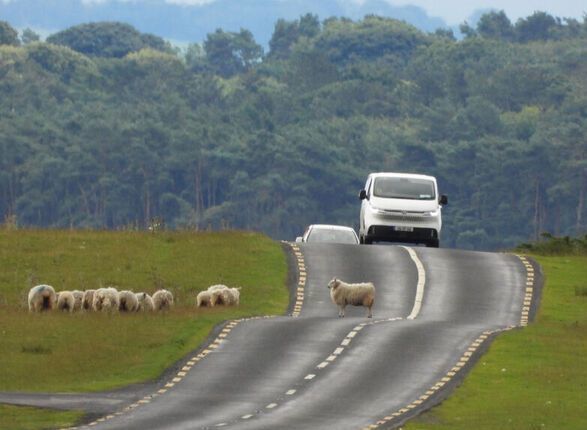A recent photo of Brussellstown Hillfort located beside Kilranelagh Hill. The ancient structure is central to the Baltinglass Hillfort Complex
By Michael Russell
In November 2020 a massive landslide near Ballybofey in County Donegal sent a whole hillside of trees and precious peat bog careering into waters that feed the Foyle River system.
Thousands of tonnes of peat and rock gouged out the landscape, destroying a great chunk of Ireland’s disappearing peatland and polluting the breeding grounds of trout and increasingly rare salmon. The damage to the scarred and denuded hillside can never be undone. And no one knows how long the river system and its spawning grounds will take to recover.
It happened during the construction of a wind farm of huge turbines at Meenbog. The catastrophe came as no surprise to objectors to the project.
A report presented to An Bord Planála, Ireland’s planning authority of last resort, predicted precisely what would happen, with new roads across the peatland and large-scale excavation for hundreds of tonnes of concrete to be poured into the bog.
An Bord Pleanála ignored the report.
Well, didn’t the developers say the threat wasn’t real? They ignored the objections of local councils, including over the border in Tyrone. They ignored objections from environmental and ecological groups, fishery and farming lobbies, as well as local communities concerned about the landscape, tourism, and still unresolved health issues raised by the proximity of turbines to habitation. The board ignored its own inspector’s report, which did not support the wind farm.
Wind turbines are good for us, you see. Even when they’re not. Even facing hard questions about where they are erected and what damage they might do to Ireland’s environment and heritage.
But whatever the importance of clean electricity, which most of us recognize will include some wind-generated energy, wind farms in rural areas are an industrial technology we have every right to question.
Just as we are encouraged to question every other industrial technology and its potential to do long-term harm. Because this is an industrial technology. Yet the need for clean energy has created an atmosphere in Ireland that suggests questions about this particular technology shouldn’t be asked.
And it is not only on issues of the environment that there is concern. Woven into the ecology and environment of Ireland is the rich substance of our archaeological and historical heritage, something we are right to believe is unique and special in the world. In places, that too is under threat from a wind energy technology that can’t simply be appropriate everywhere and anywhere.
There is currently a plan to construct a wind farm on a hill in West Wicklow, called Kilranelagh, a small outlier of the Wicklow Mountains. Unremarkable at first glance, it is part of a landscape of enormous archaeological importance. A landscape unique in Ireland and Europe, with World Heritage Site potential.
On top of Kilranelagh is a hillfort, on its slopes a stone circle. There are standing stones, including an Ogham inscription. Features align with the solstices.
On Kilranelagh’s side is the only place in Ireland you can see something physically described in an Old Irish Saga. The White Stones of Aífe, hidden and almost destroyed by forestry, are recorded in the poem Fingal Rónáin. Ancient annals tell us a High King is buried here. Kilranelagh Graveyard is one of the oldest still-functioning cemeteries in the world. At its heart are two great standing stones, still called locally the Gates of Heaven.
On this small Irish hill, our archaeology, our legends, and our ancient literature meet visibly. But there is far more. Kilranelagh is part of a great group of ancient monuments. Nine hillforts sit on the hills above the town of Baltinglass, several of them, like Brusselstown, vast.
They reach back through the Iron Age and Bronze Age. There are Neolithic remains from Ireland’s earliest inhabitants. There is nothing like the Baltinglass Cluster anywhere else. It is a site of national and international importance, still largely unexplored. And it is also a monumental landscape that can still be seen today almost as its builders saw it.
The Baltinglass Cluster is recognized by archaeologists as comparable to the Boyne Valley, or the area around Stonehenge. It is a precious asset in terms of the past and the present, with potential for ecologically sound, low-density tourism that could benefit a rural community struggling for jobs and opportunities. I
t is a landscape not only of ancient power but of unspoiled beauty. Its streams feed into the River Slaney. Buzzards and peregrines hunt overhead, and threatened curlews, Ireland’s national bird, have nested there.
All this is under threat from a wind farm on top of Kilranelagh. Hundreds of tons of concrete will pour into the un-excavated hilltop. Damage to the ecology is incalculable. And the unity of the Baltinglass Cluster, this unique hillfort landscape, after thousands of years, will be broken by the towering turbines.
Electricity must be generated in cleaner ways. But can’t we do better than destroy parts of a heritage that makes Ireland special in the world? Can’t we do better than ruin the ecology cleaner energy is meant to safeguard? Can’t we do better than shut down a rural community’s ability to protect its past and create new hope for the future? Can’t we do better than let a new industrial revolution, whatever its intentions, make mistakes we now lament in earlier revolutions?
We can’t know what the long-term future of clean energy is, but we have a right to expect something more than a sometimes ill-considered, even cavalier push into environmental technologies that sidestep proper care for the environment whose interests they claim to serve.
Ireland will not develop a truly green future without protecting a past that is also green, in every Irish sense of that word.
Michael Russell is a writer who lives below Kilranelagh Hill in County Wicklow. He has written six novels featuring a detective whose home is also in the shadow of that mountain. But he first heard of Kilranelagh fifty years ago, studying Old Irish Sagas with Professor Idris Foster, a Welshman who was the inspiration for J.R.R. Tolkien’s Bilbo Baggins. One small, odd coincidence among very many that have made so many people want to protect Kilranelagh Hill, as a place that represents a need to protect all of Ireland’s environmental heritage.








